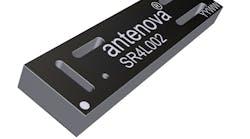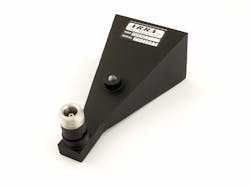This file type includes high resolution graphics and schematics when applicable.
Antennas may be among the most critical but under-appreciated components in a microwave system. They are the electromagnetic (EM) interfaces for the environment, sending and receiving EM energy and its voice, video, and data content. They come in many shapes and sizes—fitting into both the smallest mobile devices and the largest towers and battleships—with power levels that are proportional to size.
Understanding the intricacies of RF/microwave antennas can take a lifetime, but knowing some of their basic workings can help narrow the search when it is time to match an antenna to a particular application.
A transmit antenna converts conducted electrical current fed to it into EM radiation for propagation through free space. A receive antenna converts EM radiation to conducted electrical current for processing to decode the information “carried” by the modulated EM waves, such as voice, video, or data. The old expression “it takes two to tango” is particularly fitting for antennas in an RF/microwave system, although the two antennas are often of different types and sizes.
Antennas have as many different forms as any RF/microwave component, with sizes ranging from resonant circuits on integrated circuits (ICs) to parabolic dish antennas aiming out at deep space in search of a signal. The many types of high-frequency antennas include spiral, patch, blade, monopole, dipole, lens, log periodic, helix, and horn. Most antennas can be used for both transmit and receive purposes, although the physical size will have a great deal to do with the antenna’s wavelength/frequency and power-handling capability for transmit purposes.
Sizing Up Specs
When sizing up antenna performance, a handful of specifications serve to compare different units. These include frequency range, bandwidth, gain, directivity, polarization, impedance, return loss or VSWR, radiation pattern, beamwidth, efficiency, and sidelobe levels. Antennas can be constructed for maximum efficiency at selected, narrow bandwidths, or else designed for broadband, multiple-octave bandwidths, as well as for multiple frequency bands as in several different wireless communications bands.
Antenna gain usually assumes a loss-free isotropic radiator as the reference. It compares the radiated power of an antenna in question to the radiated power level of the isotropic radiator when both are fed with the same input power level. The antenna gain is then the logarithmic difference in power, measured in dBi. Sometimes a half-wave dipole is used as the reference, in which case the gain is given in dBd rather than dBi.
The physical length of an antenna will determine its operating frequency. The simplest antennas, monopoles (which can be as basic as a straight wire), are generally designed for one-quarter wavelength. Dipoles typically have a length of one-half wavelength. Another simple version, the inverted-F antenna (IFA), is the most common miniature antenna designed into or embedded in portable communications devices (such as handsets and smartphones). It is as essential as quarter-wavelength transmission line, such as microstrip, on a printed-circuit-board (PCB) substrate with a ground plane.
Although the antenna concept is simple, saving space is usually important for most embedded antenna designs, and IFAs are usually folded into different shapes for the appropriate quarter wavelength in order to save PCB real estate. For any such microstrip antenna, the choice of PCB material is critical: Circuit material properties like dielectric constant and dissipation factor can impact antenna performance.
The microstrip patch antenna is another simple antenna design for embedded applications. It is a directional antenna, with propagation and reception in the direction away from the PCB ground plane, and can be formed of half- or quarter-wavelength circuit structures.
Poor return loss at an antenna (denoted by a high VSWR) will reflect received signal power back towards the source of the signals and transmitted power back towards a transmitters electronic circuitry, typically a power amplifier driving the antenna with high-power transmit signals.
Antennas can have linear, circular, or elliptical polarization, where polarization is determined by the direction of the electric field vector.
In linear polarization, the electric field vector changes only in magnitude. In circular polarization, the direction of the electric field vector changes and rotates around the direction of propagation, in right-handed or left-handed directions. In elliptical polarization, both the magnitude and the direction of the electric field vector change. Employing antennas with consistent polarization is important, since as much as one-half the amount of transmitted signal power can be lost at the receiving end by using transmit and receive antennas with different polarization characteristics.
Antenna aperture is the area that captures energy from a passing radio wave—e.g., the area of the mouth of a horn antenna, or the area of the reflector for a dish antenna. An antenna with a larger aperture will provide more gain than an antenna with a smaller aperture. A larger-aperture antenna can receive more energy and radiate more energy in that direction than an antenna with a smaller aperture. Antennas with large apertures typically provide high efficiency, with 50% efficiency typically for horns and lenses and as much as 70% efficiency possible for parabolic dish antennas.
A traditional horn (Fig. 1) may best graphically illustrate the concept of aperture, since it is a structure formed of conductive materials with a large opening to send and receive EM energy. Depending upon frequency, horn antennas can be designed with various feed types, including coaxial connectors or waveguide flanges at higher frequencies. For those seeking more information on the types and operating parameters of RF/microwave antennas, the “Antenna Basics” white paper from Rhode & Schwarz is available as a free PDF download from the company’s website. In addition, Besser Associates offers an Antenna Design Course for those hoping to create their own configurations.
Antenna Evolution
Antennas can be large, small, active, or passive. Active antennas typically used at lower frequencies (200 MHz and less) where atmospheric noise is high and where the active circuit elements can be applied to shrink the size of the antenna at lower frequencies.
With the proliferation of wireless technologies for a growing number of applications in automotive, medical, and home automation—along with the enormous use of wireless devices expected for Internet of Things (IoT) applications in smart homes and offices—antenna designers are seeking smaller and more efficient designs that can fit within housings as small as surface-mount-technology (SMT) packages, and even on semiconductor chips.
Antennas are evolving well beyond the traditionally large structures of military radar and commercial broadcast systems. Those designers will depend more strongly on the insights offered by computer-aided-engineering (CAE) software simulation tools, notably electromagnetic (EM) simulation software.
As an example of this trend towards smaller designs, Antenova Ltd. recently unveiled its Lucida line of SMT antennas (Fig. 2) for cellular telephones, IoT applications, and multiple-input, multiple-output (MIMO) communications systems. The miniature is particularly well suited for Long-Term-Evolution (LTE) wireless applications. It operates in all mobile communications bands, including 700, 850, 900, 1,800, 1,900, 2,100, 2,300 to 2,400, and 2,500 to 2,590 MHz. The miniature antenna is also versatile; it can be used in base stations, as well as portable and wearable wireless devices.
The Lucida antenna measures just 35.0 × 8.5 × 3.2 mm. It can be placed on a PCB as any other SMT component, providing a great deal of layout flexibility when attempting to miniaturize high-frequency products for these competitive communications applications. The Lucida antenna is part of the firm’s lamiiANT line of antennas, which are manufactured from high-quality PCB materials with consistent dielectric constant.
Another recent novel antenna design, the latest addition to the Clarity family of antennas from Pulse Electronics Corp., is intended for UHF use, including at 380 to 520 MHz and 698 to 960 MHz. It meets the requirements set by the International Fire Code and National Fire Protection Association (IFC/NFPA) for public safety for in-building communications systems.
The antenna features a plastic radome just 311 mm in diameter and protruding just 9.5 mm below the ceiling of a building, allowing for an unobtrusive profile for in-building applications. In spite of the small size, (Fig. 3) it maintains clear communications throughout multiple-story buildings.
Olivier Robin, general manager for Pulse Electronics’ Wireless Infrastructure business unit, notes that this is an antenna that performs as required without being an eyesore: “It is critical that reception be clear, reliable, and continually available in buildings where public safety is involved—such as for public safety repeater systems in hospitals, malls, high-profile office buildings, government facilities, schools, and low-ceiling basement deployments—yet the aesthetics and appearance of antennas can make architects and designers reluctant to install them.”
This file type includes high resolution graphics and schematics when applicable.




